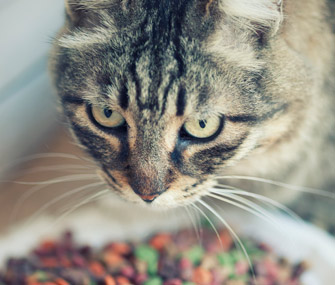How to Make Eating Easier, and More Enjoyable, for an Aging Cat
Published on January 29, 2016
Skip To

But there’s one sure thing you should definitely keep an eye on as your cat gets older: How well does she eat? Whether she’s a nibbler or a gobbler, the way she eats can be a solid clue to her well-being.
What to Look For
You may notice that your cat seems to have gotten picky in her old age. Picky as in she picks up a piece of kibble in her mouth and then drops it. That doesn’t necessarily mean she doesn’t like the food, but it’s a good sign that her mouth is the gateway to gums that are red, inflamed and swollen. When I examine some cats, the gums look as if they’ve been hit with a flamethrower and a jackhammer.Sadly, most cats don’t get the preventive dental care they need and deserve. Cats with painful periodontal disease are more the norm than older cats with good oral health. It’s been estimated that by 2 years of age, 70 percent of cats suffer from some kind of periodontal disease, which can progress to bone and tooth loss. There are no kitty dentures, so once teeth are lost, your cat is going to be a gummer — and even that can be excruciatingly painful.
If your cat is having trouble eating, ask your veterinarian to give your cat an oral exam. She may recommend a professional cleaning, including X-rays to assess for problems under the gums, and possibly the removal of painful teeth to help your cat feel better and get back to her regular eating habits.
Make Meals a Pleasure Again
If your older cat has lost a lot of teeth, or if she’s simply less interested in her kibble, talk to your veterinarian about a possible diet change.Just like humans, a cat’s sense of smell often weakens with age, so we sometimes have to amp up the food’s aroma before older cats can smell and taste it. Whether you are feeding dry or canned food, warm it slightly in the microwave before serving (it may help to add a little water to the dry kibble before warming). Heat it for seven to 15 seconds, stir it thoroughly and test it with your finger to make sure it’s not too hot for your cat’s mouth.
There are also commercial flavor enhancers you can add to your cat’s food and special therapeutic foods that are formulated specifically for sick or elderly pets who don’t want to eat. Ask your veterinarian for details.
Most important, remember that tuna breath is only funny in cartoons and do your best to keep your cat’s mouth healthy throughout life.
More on Vetstreet:

